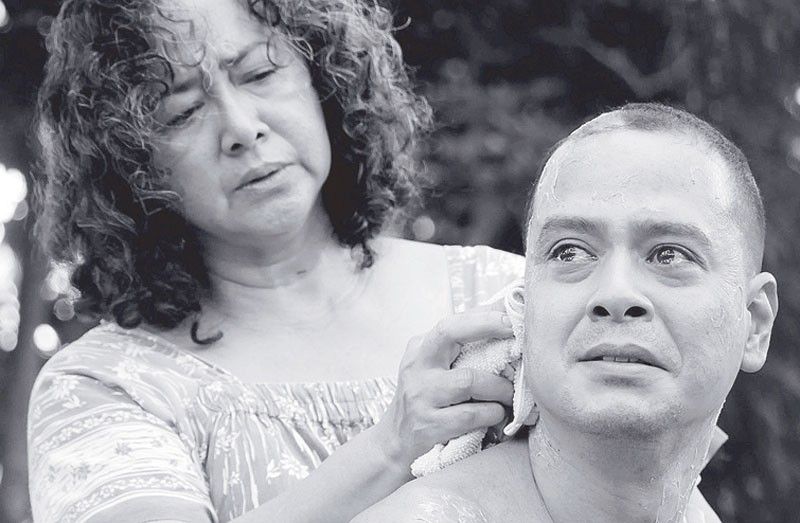Gone with the waves in Venice and San Isidro


One might say Lav Diaz’s latest film, Kapag Wala Nang Mga Alon (When the Waves are Gone), was constructed around a photograph taken during the drug war, the Pieta-like cradling of a user/pusher victim by his lover somewhere in the Pasay Rotonda area in the dead of night. The photo by Raffy Lerma did the rounds of news wires, a succinct statement on the ruthless apathy and killing culture of the anti-illegal drugs campaign of the previous administration.
This doubtless caught the filmmaker’s eye and serves now as a peg of a three-hour morality tale pared down to a cat-and-mouse revenge narrative between teacher and student in the police academy and hatchet men of the war on narcotics, and their subsequent showdown on the waterfront of a typical small town called San Isidro or is it Halyo city, a veritable backwoods with more than its fair share of streetwalkers.
John Lloyd Cruz plays Lt. Hermes Papauran, a seemingly upright policeman, who is labeled as an officer and a wife beater by an anonymous heckler on the classroom blackboard, while Ronnie Lazaro is Sgt. Primo Macabantay the demented former teacher of Papauran, just recently pardoned from prison, time served following an operation of his ex-student on police corruption and other deadly dealings.
Papauran is a friend of Lerma (DM Boongaling), and their dialogue is replete with similarities between the work of a journalist and that of a policeman: Shoot first, ask questions later.
Papauran obviously has a violent streak as seen in his literal dressing down of his wife and her lover, whom the investigator catches in flagrante delicto in an apartment off JP Rizal St. How many cases have I solved on a J Rizal St. all across the Philippines, the cuckold cannot help but ask.
The lieutenant develops an itchy skin rash and likely auto-allergy in reaction to all the extrajudicial killings he’s taken part in, and so takes an indefinite leave from the police force and returns to the province, always a strong suit of the director with the wide panning shots of the idle wild and sea shore, like a coming to terms with one’s origins, including an elder sister teacher Nerissa (Shamaine Centenera) living off the lay of the land.
Meanwhile, Macabantay is hot on Papauran’s heels, the demented ex-convict providing a showcase for Lazaro probably taking a page from animator Roxlee’s renditions of Birdman, or is it Flash Asoge forever stalking the shadow of Siokoy Ronald?
Alternately preacher man and sexual predator, Macabantay checks into a seedy hotel from where he intends to corner his quarry, while getting into a few tragicomic scrapes with hookers through humor that doesn’t come any blacker. Looks like Lazaro enjoyed playing the role, certainly as memorable as his take on the Filipino guerrilla during Japanese Occupation who deflowered the Cherie Gil character in Oro Plata Mata.
Conversation between the siblings Papauran also recalls dialogue from past Diaz films, in particular Tolstoy’s “God sees the truth but waits” from Death in the Land of Encantos, but here Nerissa says her missing husband is like God because absent, but such nihilism is par for the course for Diaz, whose prolific output has a few reviewers and critics fearing he might paint himself into a corner.

We already get a glimpse of such dead ends out-Nietszcheing Nietzsche in the auteur’s two immediate past films, both also starring Cruz, Historya ni Ha and Isang Salaysay ng Karahasang Pilipino, where he separately traces a universal history of ventriloquism and violence through main characters with odds congenitally stacked up against them, though Ha is admittedly more hopeful in its denouement, if rather long drawn in the recitation of alphabet among villagers.
Might you also be reminded of the discourse in Century of Birthing, between Perry Dizon and the late Dante Perez, in paraphrase saying that one can do one’s best to change the world but still be called pretentious. Or them saying that we will remember the world because of cinema, even if, alas, butterflies have no memories.
Kapag Wala Nang Mga Alon had its premiere at the Venice Film Festival in the past week, to mostly rave reviews, but special mention should be made of that final showdown between Papauran and Macabantay on the waterfront of a small town at sunrise, where things have as much potential to end as to begin. The latest Diaz film is a damning indictment of the past war on drugs and its attendant hypocrisy, all sound and fury signifying hollowmen fighting their own shadows if not oblivion itself, whose fate is sure erasure from Earth were it not for all their ranting.
Waves always disappear at low tide, but no such fear of painting into corners because film has a way of reinventing itself like 16 mm courtesy of Larry Manda’s camera even in blackest night.
- Latest
- Trending



















 Exclusive
Exclusive












